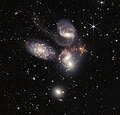Datei:Stephan's Quintet taken by James Webb Space Telescope.jpg

Originaldatei (12.654 × 12.132 Pixel, Dateigröße: 63,39 MB, MIME-Typ: image/jpeg)
Diese Datei stammt aus Wikimedia Commons und kann von anderen Projekten verwendet werden. Die Beschreibung von deren Dateibeschreibungsseite wird unten angezeigt.

|
Diese Datei ist die JPEG-Version der ursprünglichen TIF-Datei File: Stephan's Quintet taken by James Webb Space Telescope.tif.
Allerdings sollten Bearbeitungen auf der originalen TIF vorgenommen werden, um Qualitätsverlusten vorzubeugen. Nach der Bearbeitung müssen beide Versionen aktualisiert werden. Bitte keine Bearbeitung auf Basis dieser Version! |
Beschreibung
| Warnung | Diese Originaldatei ist sehr hochauflösend. Es könnte sein, dass diese Datei nicht richtig geladen werden kann oder dass der Browser einfriert, wenn die Datei in voller Größe geöffnet wird. Um diese Probleme zu vermeiden, kann der interaktive Bildbetrachter (ZoomViewer) verwendet werden. |
|---|
| BeschreibungStephan's Quintet taken by James Webb Space Telescope.jpg |
English: An enormous mosaic of Stephan’s Quintet is the largest image to date from NASA’s James Webb Space Telescope, covering about one-fifth of the Moon’s diameter. It contains over 150 million pixels and is constructed from almost 1,000 separate image files. The visual grouping of five galaxies was captured by Webb’s Near-Infrared Camera (NIRCam) and Mid-Infrared Instrument (MIRI).
With its powerful, infrared vision and extremely high spatial resolution, Webb shows never-before-seen details in this galaxy group. Sparkling clusters of millions of young stars and starburst regions of fresh star birth grace the image. Sweeping tails of gas, dust and stars are being pulled from several of the galaxies due to gravitational interactions. Most dramatically, Webb’s MIRI instrument captures huge shock waves as one of the galaxies, NGC 7318B, smashes through the cluster. These regions surrounding the central pair of galaxies are shown in the colors red and gold. This composite NIRCam-MIRI image uses two of the three MIRI filters to best show and differentiate the hot dust and structure within the galaxy. MIRI sees a distinct difference in color between the dust in the galaxies versus the shock waves between the interacting galaxies. The image processing specialists at the Space Telescope Science Institute in Baltimore opted to highlight that difference by giving MIRI data the distinct yellow and orange colors, in contrast to the blue and white colors assigned to stars at NIRCam’s wavelengths. Together, the five galaxies of Stephan’s Quintet are also known as the Hickson Compact Group 92 (HCG 92). Although called a “quintet,” only four of the galaxies are truly close together and caught up in a cosmic dance. The fifth and leftmost galaxy, called NGC 7320, is well in the foreground compared with the other four. NGC 7320 resides 40 million light-years from Earth, while the other four galaxies (NGC 7317, NGC 7318A, NGC 7318B, and NGC 7319) are about 290 million light-years away. This is still fairly close in cosmic terms, compared with more distant galaxies billions of light-years away. Studying these relatively nearby galaxies helps scientists better understand structures seen in a much more distant universe. This proximity provides astronomers a ringside seat for witnessing the merging of and interactions between galaxies that are so crucial to all of galaxy evolution. Rarely do scientists see in so much exquisite detail how interacting galaxies trigger star formation in each other, and how the gas in these galaxies is being disturbed. Stephan’s Quintet is a fantastic “laboratory” for studying these processes fundamental to all galaxies. Tight groups like this may have been more common in the early universe when their superheated, infalling material may have fueled very energetic black holes called quasars. Even today, the topmost galaxy in the group – NGC 7319 – harbors an active galactic nucleus, a supermassive black hole that is actively accreting material. In NGC 7320, the leftmost and closest galaxy in the visual grouping, NIRCam was remarkably able to resolve individual stars and even the galaxy’s bright core. Old, dying stars that are producing dust clearly stand out as red points with NIRCam. The new information from Webb provides invaluable insights into how galactic interactions may have driven galaxy evolution in the early universe. As a bonus, NIRCam and MIRI revealed a vast sea of many thousands of distant background galaxies reminiscent of Hubble’s Deep Fields. |
||
| Datum | NIRCam: 11 June 2022; MIRI: 11-12 June, 1 July 2022 | ||
| Quelle | https://webbtelescope.org/contents/media/images/2022/034/01G7DA5ADA2WDSK1JJPQ0PTG4A | ||
| Urheber |
Image:
|
||
| Andere Versionen |
|
Lizenz
| Public domainPublic domainfalsefalse |
| This file is in the public domain because it was created by NASA, ESA and CSA. NASA Webb material is copyright-free and may be freely used as in the public domain without fee, on the condition that only NASA, STScI, and/or ESA/CSA is credited as the source of the material. This license does not apply if source material from other organizations is in use. The material was created for NASA by Space Telescope Science Institute under Contract NAS5-03127. Copyright statement at webbtelescope.org. For material created by the European Space Agency on the esawebb.org site, use the {{ESA-Webb}} tag. |
 |
Kurzbeschreibungen
In dieser Datei abgebildete Objekte
Motiv
image/jpeg
Dateiversionen
Klicke auf einen Zeitpunkt, um diese Version zu laden.
| Version vom | Vorschaubild | Maße | Benutzer | Kommentar | |
|---|---|---|---|---|---|
| aktuell | 19:33, 12. Jul. 2022 |  | 12.654 × 12.132 (63,39 MB) | wikimediacommons>Habitator terrae | c:User:Rillke/bigChunkedUpload.js: |
Dateiverwendung
Die folgende Seite verwendet diese Datei:


